....the beauty that livens up any painting
Reflected light is created by light from a source, like the sun or an incandescent bulb, that shines on a colorful object, and throwing the color from that object onto another plane.
A red apple on a white tablecloth, for instance, will have red in the shadow, or red cast upon an object lying next to it. A porch that has a red carpet on it, will have red reflected on the ceiling, just from the sun shining on the floor. That light bounces up as far away as the ceiling. Many people have never really looked for this phenomenon. But the artist’s eye sees it clearly.It is not the color you see reflected in a shiny surface. That is a reflection, not reflected light.
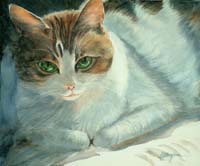 In the painting of the cat, Chadwick, the light from the surface on which he lay is reflected on his chin. It has no particular color because the original surface is white. This is the kind of reflected light that happens in snow scenes where the surface of the snow creates a light against or under another object. In winter, we have the brilliance of snow to light up the landscape. The radiant color may not be there, but the reflection of light shows up just as well. In the painting of the cat, Chadwick, the light from the surface on which he lay is reflected on his chin. It has no particular color because the original surface is white. This is the kind of reflected light that happens in snow scenes where the surface of the snow creates a light against or under another object. In winter, we have the brilliance of snow to light up the landscape. The radiant color may not be there, but the reflection of light shows up just as well.
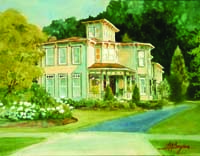 In the painting of the house, you can see the golden light of late afternoon bouncing from one plane into a shaded surface, just above the porch roof. You can see these things better if you enlarge the images by clicking on them. In the painting of the house, you can see the golden light of late afternoon bouncing from one plane into a shaded surface, just above the porch roof. You can see these things better if you enlarge the images by clicking on them.
Flesh tones in a face are affected by the color of a shirt the person is wearing. A blue shirt will turn the underside of the chin to a bluish tone. Our foreheads often have a blue light on them from the light in the sky. Sometimes these tones are very faint; other times they are very distinct.
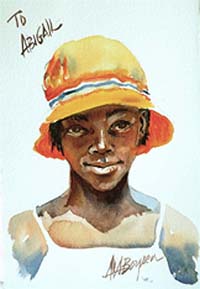 Abigail is from northern Africa where the skin tones are very dark, almost a true black. Abigail is from northern Africa where the skin tones are very dark, almost a true black.
However, with this bright yellow hat in the brilliant sunlight of Africa, her skin tones turn more golden. Her shoulders are reflecting the blue sky above.
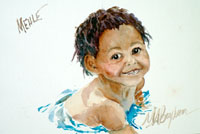 Mehle, the little boy in the swimming pool, has the color of the water reflected on his chest. Of course, water reflects the color of the sky. So you see, reflected light is all around us. Mehle, the little boy in the swimming pool, has the color of the water reflected on his chest. Of course, water reflects the color of the sky. So you see, reflected light is all around us.
Reflected light keeps shadows from being dull and grey. I once had a person ask me what grey I used for shadows. I tried to explain that shadows were not grey. “Yes they are”, said she! I then explained that shadows are made of all the colors of the rainbow. They can be more red, or blue, or green, or purple at any given time, depending on the amount of reflected light that is in them.
I can remember that during a creative session for teachers at the Gestault Institute in Cleveland, everyone in the room was given the task of teaching the rest of the group something, anything. It was about 3 p.m. on a sunny February day with the landscape covered in snow. At that time of day in winter, the sun is low and the pink glow on the snow was reflected on the white interior walls of the room. I decided to ask everyone what color the walls were. Every person in the room said, “white”. They had not yet learned to look for the actual color, but were stating the local color, the color that the walls had been painted. That day, I taught people to see!
With that in mind, I also remember choosing new paint for my bedroom walls, and new carpet to match. A bad decision! The color was lime green. That color was pale enough, but when the walls AND the floor were covered with the pale green, it was so intense that I wanted to back out of the room! Each surface was casting its color on the others and creating a more intense hue. I had been out of town when all this was done, and for the first time in my life, had paid to have the work done instead of doing it myself. What a shock when I returned. However, I decided we would just have to live with it.
It is the artist’s duty to educate the viewer with color. Many times we exaggerate the color just to make a painting lively. These are the paintings that capture the interest of the viewer and give the work a passion that makes people want to own it.
See Reflected light in a portrait (video)
|
My E-Books

Learning the Basics of Watercolor
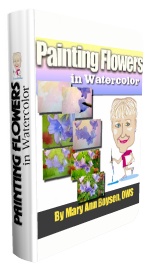
Painting Flowers in Watercolor

Painting on Watercolor Canvas |

